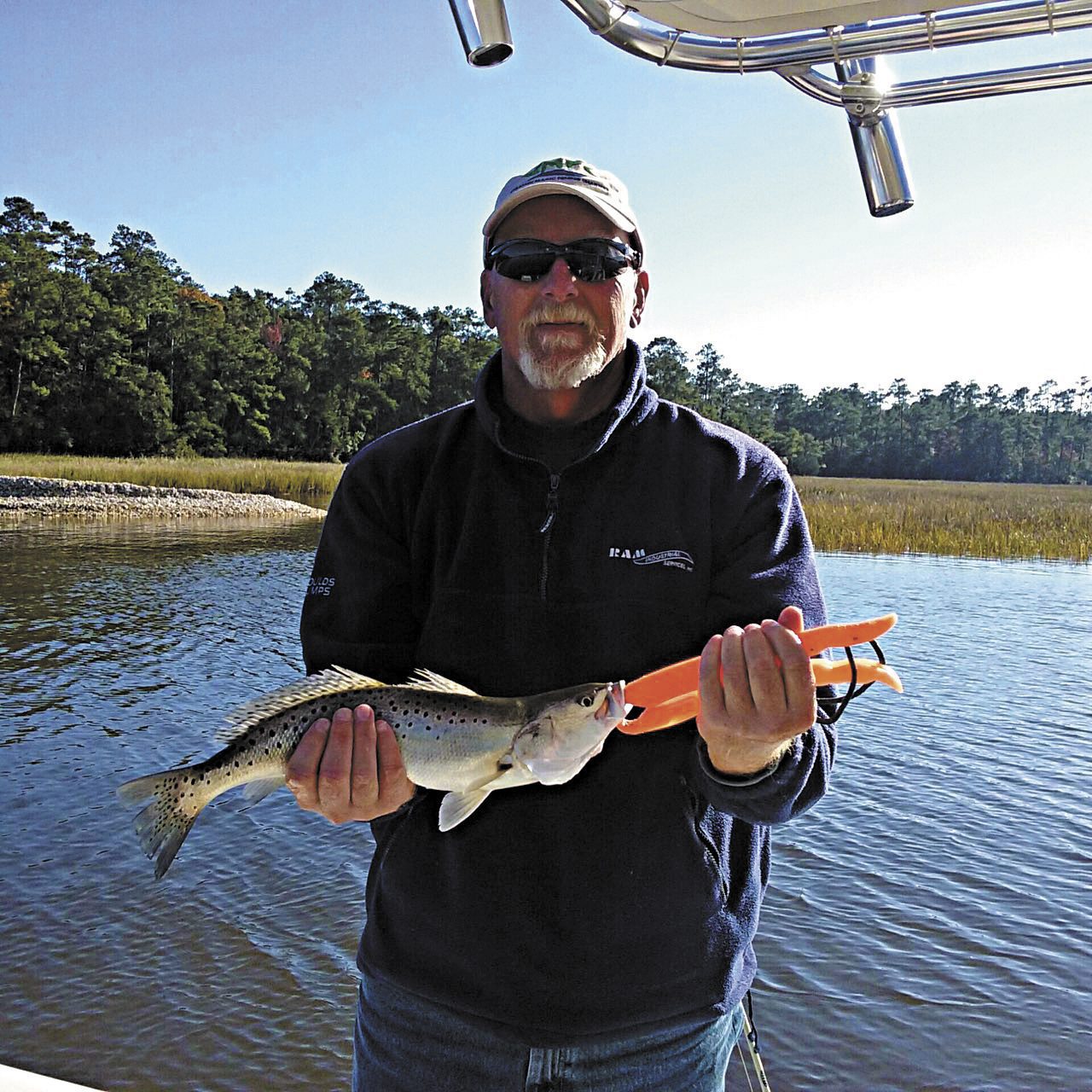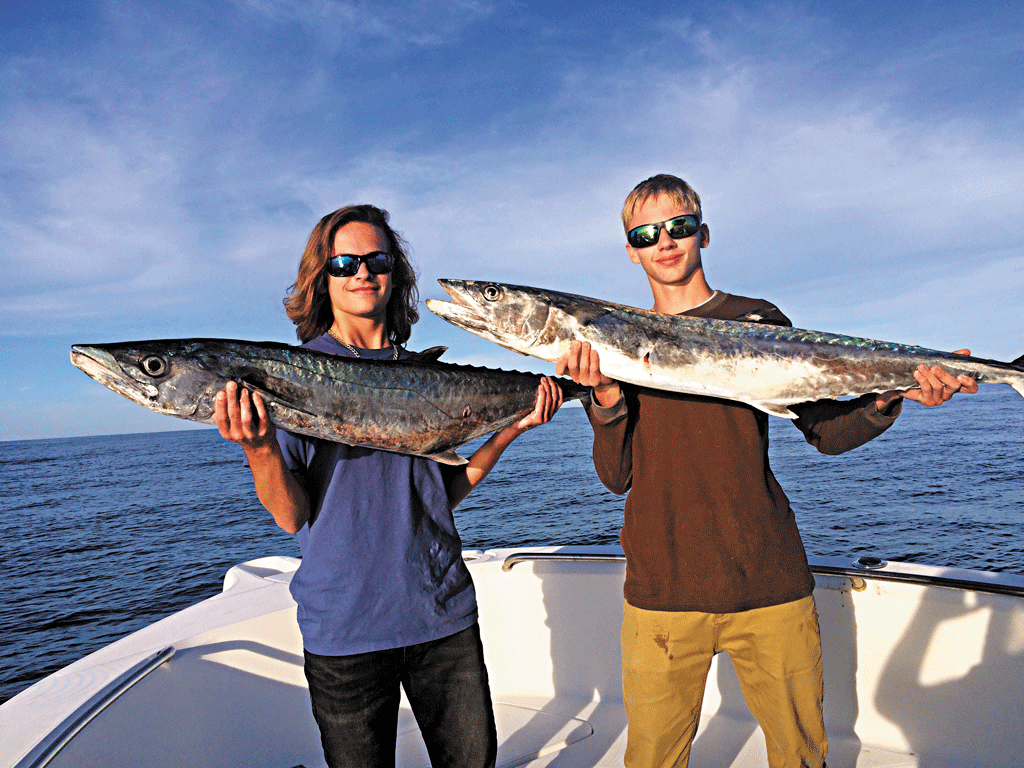North Myrtle Beach/Little River – Winter 2019-2020
Patrick, of Captain Smiley Fishing Charters, reports that inshore surface water temperatures on the north end of the Grand Strand have dropped into the lower 60s, but the typically clean cold water is still murky.
This is one of the best times of year to fish in the Little River area, and it’s a no-brainer to target trout right now. Last year at this time they were catching a bunch of fish in the 13” range, while this year the average size is an impressive 18”, with plenty of fish in the 20-25” range.
Most of the fishing efforts have been in targeting the ICW, but anglers are also catching fish in the shallow creeks. The fish are off ledges, in deeper holes, and around oyster beds beside grass. Basically, they are as shallow as 2’ and down to about 10-12’. Tide does not seem to matter as long as there is moving water in either direction. Live shrimp, D.O.A. shrimp, Vudu shrimp, and Trout Tricks are all working.
There are redfish and black drum around in the same areas, although most of the redfish have been small (in the 15-18” range). There are not a lot of 20-27” fish with the cooler water. The black drum are mainly in the 18-20” range, and they will eat live or cut shrimp. The reds will eat anything, and some of the bigger trout are also being caught on minnows.
Anglers are still picking up some short flounder.
From December through mid-March, you can expect to find plenty of redfish in the shallows, where anglers should be ready to fish stealthy. Gulp shrimp rigged weed-less and jerk shads often produce best for the winter action.

Jeff Musser, of Philadelphia, with a speckled trout that was fooled by a Gulp swimbait. He was fishing with Capt. Bob Strange, of Strange Magic Fishing Charters.
Bob, of Strange Magic Fishing Charters, reports that trout have been hitting consistently, and they’re attacking Gulp baits pinned to jig heads. The numbers aren’t quite as good as last year’s, but hopefully they will improve. Soft plastics in white and/or chartreuse will work best, but mud minnows under popping corks will also produce. With artificials, wen the water temperature gets low, remember to slow your presentation.
Using mud minnows will put the redfish into play as well. At high tide, work the shorelines of creeks and the ICW, and then on the lower tide stages, look to target deeper water, especially in the ICW. Don’t be surprised to pull in a flounder every now and then while jigging, but for the most part, the bigger flounder have made their way back into the ocean.
Black drum are still around and are biting around docks (along with redfish). Fresh shrimp is the ticket for both, with mud minnows working better for the reds. The large redfish have just about disappeared from the Little River inshore waters, as they are more than likely ocean bound. On nice days, it can payoff to cruise the beachfront looking for some holdouts schooling right past the breakers.
When the water temps get into the lower 50s and upper 40s, the smaller redfish will start their winter schooling pattern to the backs of creeks where the muddy, shallow water will be a couple of degrees warmer. These reds will be very spooky, so a stealth approach is important, as is keeping your distance and casting to the edges of any schools you come upon. Gulp baits and mud minnows will be the ticket. If a school breaks up or moves even further back into the shallows, it’s not a bad idea to wait it out until the school either reforms or comes back to you.
With cooling water, dolphin will be cruising around the ICW and in some creeks. When you spot any dolphin, you might just as well move on because the fish you’re trying to catch are on the menu and they will vacate the area. Another suggestion for winter fishing is to keep moving. If you don’t have success after 15 minutes or so, go to the next spot to optimize your efforts.

Cooper Kirkland and Tyler Cameron with a pair of 30 lb. king mackerel. They were fishing at the Horseshoe aboard the “Carolina Saltwater” out of Ocean Isle.
Cameron, of Little River Fishing Fleet, reports that wahoo have been scarce but big, with at least one 80 lb. fish coming in over the past few weeks. Most of the wahoo action is coming on ballyhoo behind black and purple skirts.
At the Stream, there’s been limits of snapper, gags, and scamps, as well as the occasional large black sea bass.
The king mackerel bite has been steady in the 80’ range, and the best tactic has been cigar minnows.
Running 30-50 miles offshore to bottomfish has been producing gag grouper, black sea bass, scamp grouper, and beeliners.
Winter is the best time for black sea bass, which get bigger and come closer to shore in the cooler months. In these colder months, you can find the best bite in the 60-80’ range.
Larry, of Voyager Fishing Charters, reports that at the Gulf Stream the bottom fishing remains solid. Scamp grouper, beeliners, grunts, triggerfish, and amberjacks are all being landed, with a variety of cut baits getting the job done.
Targeting areas around the 30-mile mark has produced plenty of action with king mackerel. Trolling with dead cigar minnows has been the key to landing limits of fish. Good numbers of false albacore are also in the mix.
The nearshore bite has started to pick up. Black sea bass, porgies, and bluefish have all been feeding well near the bottom. Anglers should see the black sea bass bite improve and move closer in as the water temperature continues to drop.
Steve, of Cherry Grove Pier, reports that anglers are still hooking black drum from the pier, as well as good numbers of whiting and croaker. Shrimp has been the number one bait for anything on the bottom.
The winter months should see whiting, croaker, perch, black drum, and the possibility of a spadefish. All the bigger fish will be going dormant until the end of February.





